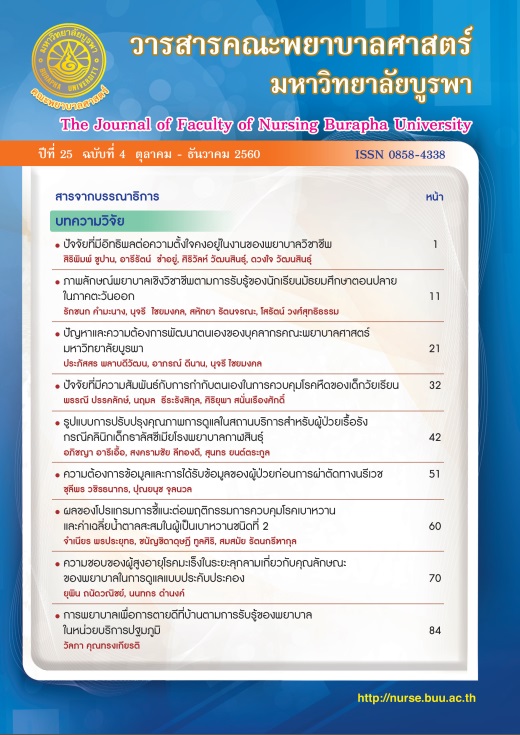ความชอบของผู้ป่วยสูงอายุโรคมะเร็งในระยะลุกลามเกี่ยวกับคุณลักษณะของพยาบาลในการดูแลแบบประคับประคอง*
Nurse-Characteristics Preferences of Older Adult Patients with Advanced Cancer in Palliative Care
คำสำคัญ:
ความชอบของผู้ป่วยเกี่ยวกับคุณลักษณะของพยาบาล, ผู้ป่วยสูงอายุโรคมะเร็งในระยะลุกลาม, การดูแลแบบประคับประคอง, Palliative Care, Older Adult Patients with Advanced Cancer, Nurse-Characteristics Preferencesบทคัดย่อ
บทคัดย่อ
การศึกษาครั้งนี้เป็นการศึกษาวิจัยเชิงคุณภาพ โดยมีวัตถุประสงค์เพื่อศึกษาความชอบ
ของผู้ป่วยสูงอายุโรคมะเร็งในระยะลุกลามเกี่ยวกับคุณลักษณะของพยาบาลในการดูแลแบบ
ประคับประคอง กลุ่มตัวอย่างเป็นผู้สูงอายุ (อายุ ≥ 60 ปี) ได้รับการวินิจฉัยว่าเป็นโรคมะเร็ง
โดยแพทย์เจ้าของไข้ ขณะเข้ารับการรักษาในโรงพยาบาลมะเร็งชลบุรี และได้รับการสุ่มอย่างง่าย
ตามเกณฑ์ที่กำหนด คือ โรคมะเร็งอยู่ในระยะลุกลาม (คะแนนจากการประเมินด้วย Palliative Performance Scale version2 ≤ 60) กลุ่มตัวอย่างมีจำนวน 20 คน ได้รับการเชิญและเข้าร่วม
การให้สัมภาษณ์ในเชิงลึกตามแบบสัมภาษณ์กึ่งโครงสร้างที่ได้พัฒนาจากการทบทวนวรรณกรรม
แล้วถูกตรวจสอบความตรงของเนื้อหาจากผู้ทรงคุณวุฒิ ข้อมูลที่ได้ถูกนำมาวิเคราะห์เนื้อหา ผลการศึกษา พบว่า คุณลักษณะของพยาบาลที่ผู้สูงอายุโรคมะเร็งในระยะลุกลามมีความชอบและต้องการในการให้การดูแลแบบประคับประคองที่เน้นความสุขสบายเป็นสำคัญนั้น มี 4 ประเด็น
ได้แก่ พฤติกรรม/บุคลิกของพยาบาลที่ต้องการ (การสื่อสารที่มีประสิทธิภาพ) การพยาบาลที่ชอบ (การบรรเทาอาการไม่สุขสบาย การบริการช่วยเหลือผู้ป่วย การให้ความรู้) ลักษณะของวิชาชีพพยาบาล (เป็นวิชาชีพที่มีความรู้ ทักษะและจริยธรรม) และคุณค่าของพยาบาล (พยาบาลสามารถ
ให้การพยาบาลในระดับที่ดีทุกคน) จากผลการศึกษาวิจัย สรุปได้ว่า การดูแลแบบประคับประคองที่เน้นความสุขสบายของผู้ป่วยสูงอายุที่มีโรคมะเร็งในระยะลุกลามนั้นจำเป็นต้องมีพยาบาลที่มีความรู้และทักษะเกี่ยวกับการสื่อสารที่มีประสิทธิภาพ การบรรเทาอาการไม่สุขสบายโดยเฉพาะความเจ็บปวด และมีจริยธรรมในการพยาบาลความสุขสบาย ทั้งนี้เพื่อการพัฒนาคุณภาพการพยาบาล
-----------------------------------
Abstract
This qualitative research aimed to study nurse-characteristics preferences of older adult patients with advanced cancer. The patients who were diagnosed with cancer by their primary doctors, admitted to Chonburi Cancer Hospital (Length of stay ≥ 7 days), and met other inclusion criteria--score from the assessment by the Palliative Performance Scale version2 ≤ 60, as illness with advanced cancer--were recruited by the purposive sampling. There were 20 samples. They were invited
and interviewed in depth following the Semi-Structured Interview Guide which was developed by reviewing literature and tested for the content validity. The content analysis was used to analyze the data. Three nursing experts on cancer care, palliative care, end-of-life care, and care for the elderly verified the prior categories. The result showed 4 categories emerged. These were (1) needed behaviors/
personalities of nurses (effective communication); (2) preferred nursing care
(relieving discomfort, helping patient service, and providing knowledge);
(3) characteristics of nursing professional (consisting of knowledge, skills, and ethics);
(4) values of nurses (Every nurse could provide good nursing care); In summary, to improve quality of nursing care, palliative care focusing on comfort care for older adult patients with advanced cancer needs professional nurses who have sufficient knowledge and skills in effective communication, relieving discomfort (especially pain), and ethics for comfort care.
References
พ.ศ. 2556 สืบค้นเมื่อ 10 กันยายน พ.ศ. 2559 เข้าถึงได้จาก http://www.nci.go.th/th/
File_download/Nci%20Cancer%20Registry/HOSPITAL-BASED%202013%20All%20
(Online)%20(1).pdf
คณะกรรมการผู้สูงอายุแห่งชาติ. (2557). สถานการณ์ผู้สูงอายุไทย พ.ศ. 2557 (Situation of the
elderly 2014). สืบค้นเมื่อ 10 กันยายน พ.ศ. 2559 เข้าถึงได้จากhttp://thaitgri.org/?p=36
สถาบันมะเร็งแห่งชาติ กรมการแพทย์. (2556). แผนการปองกันและควบคุมโรคมะเร็งแหงชาติ.
สืบค้นเมื่อ 10 กันยายน พ.ศ. 2559 เข้าถึงได้จาก http://www.nci.go.th/th/
File_download/D_index/NCCP_2556-2560.pdf
American Cancer Society. (2015). Cancer Facts & Figures 2015 Retrieved September
10, 2016, from http://www.cancer.org/research/cancerfactsstatistics/
cancerfactsfigures2015/
Anderson, F., Downing, G. M., Hill, J., Casorso, L., & Lerch, N. (1996). Palliative
Performance Scale (PPS): A new tool. Journal of Palliative Care, 19, 5-11.
Chulacencer. (ม.ป.ป.). ความรู้เกี่ยวกับยาเคมีบำบัด. สืบค้นเมื่อ 10 กันยายน พ.ศ. 2559 เข้าถึงได้
จาก http://www.chulacancer.net/patient-list-page.php?id=323
Efstathiou, N., & Clifford, C. (2011). The critical care nurse's role in End-of-Life care:
issues and challenges. Nursing In Critical Care, 16(3), 116-123.
Egan, K. A., & Labyak, M. J. (2010). Hospice palliative care: A model for quality
end-of-life care. In B. R. Ferrell & N. Coyle (Eds.). Textbook of palliative
care. (3rd ed., pp. 13-46). New York: Oxford University Press.
Goldsmith, J., Ferrell, B., Wittenberg-Lyles, E., & Ragan, S. L. (2013). Palliative Care
Communication in Oncology Nursing. Clinical Journal Of Oncology Nursing,
17(2), 163-167.
Hawthorn, M. (2015). The importance of communication in sustaining hope at the
end of life. British Journal Of Nursing, 24(13), 702-705.
Ho, F., Lau, F., Downing, M. G., & Lesperance, M. (2008, August 4). A reliability
and validity study of the Palliative Performance Scale. BioMed Central
Palliative Care, 7(10), 1-10,
Jennings, B. M., Staggers, N. (1999). A provocative look at performance
Measurement (Management and clinical outcomes). Nursing Administration
Quarterly, 24(1), 1-14.
Kolcaba, K. (2003). Comfort theory and practice. New York: Springer
Publishing Company.
Lau, F., Downing, G. M., Lesperance, M., Show, J., & Kuziemsky, C. (2006). Use of
The Palliative Performance Scale in end-of-life prognostication. Journal of
Palliative Medicine, 9(5), 1066-1075.
Mcleod, S. A. (2009). Attitudes and behaviors. Retrieved, July 24, 2014, from
http://www.simplypsychology.org/attitudes.html.
National Council on Aging (n.d.) Chronic Disease Management Retrieved July 17,
2016, from https://www.ncoa.org/healthy-aging/chronic-disease/
Nekuzad, N., Torab, T. A., Mojab, F., Alavi-Majd, H., Azadeh, P., & Ehtejab, G. (2012).
Effect of External Use of Sesame Oil in the Prevention of Chemotherapy-
Induced Phlebitis. Iranian Journal Of Pharmaceutical Research, 11(4), 1065-
1071.
Nilmanat,K., Chailungka, P., Phungrassami, T., Promnoi, C., Tulathamkit, C., Noo-urai,
et al. (2010). Living with suffering as voiced by Thai patients with terminal
advanced cancer. International Journal of Palliative Nursing , 16(8), 393-399.
Oechsle, K., Goerth, K., Bokemeyer, C., & Mehnert, A. (2013). Symptom burden in
palliative care patients: perspectives of patients, their family caregivers, and
their attending physicians. Supportive Care In Cancer, 21(7), 1955-1962.
Reinke, L. F., Shannon, S. E., Engelberg, R., Dotolo, D., Silvestri, G. A., & Curtis,
J. R. (2010). Nurses’ identification of important yet under-utilized end-of-life
care skills for patients with life-limiting or terminal illness. Journal of Palliative
Medicine, 13(6), 753-759.
Tai, S. Y., Lee, C. Y., Wu, C. Y, Hsieh, H. Y., Huang, J. J., Huang, C. T., Chien, C. Y. (2016).
Symptom severity of patients with advanced cancer in palliative
care unit: longitudinal assessments of symptoms improvement. BMC Palliative
Care, 151-157. doi:10.1186/s12904-016-0105-8.
Simon, S. T., Ramsenthaler, C., Bausewein, C., Krischke, N., & Geiss, G. (2009).
Core attitudes of professionals in palliative care: A qualitative study.
International Journal of Palliative Nursing, 15(8), 405-410.
Steven, A., White, G., Marples,G., & Atkinson, J. (2014). End of life care: An
educational pathway for community nurses. Primary Health Care, 24(1), 18-25.
Swift, J. K., Callahan, J. L., & Vollmer, B. M. (2011). Preferences. Journal of Clinical
Psychology in Session, 67(2), 155-165.
Tanatwanit, Y. (2011). Comfort as experienced by Thai older patients with advanced
cancer. (Doctoral Dissertation, The Catholic University of America, 2001).
Dissertation Abstracts International (17), (UMI No. 3439981)
Tang, S. T., & McCorkle, R. (2002). Appropriate time frames for data collection in
quality of life research among cancer patients at the end of life. Quality of Life
Research, 11, 145-155. Retrieved March 10, 2007, from
http://web.ebscohost.com.proxycu.wrle.org/ehost/pdf?vid=6&hid=118&sid
=c5fcc652-5fca-43ee81bc-27e0ae164ca8%40sessionmgr103
Thacker, K., S. (2008). Nurses' advocacy behaviors in end-of-life nursing care. Nursing
Ethics, 15(2), 174-185.
World Health Organization (WHO). (2014). Cancer. Retrieved September 10, 2016,
from http://www.who.int/mediacentre/factsheets/fs297/en/
Zhang, Y. (2006). Content analysis (qualitative, thematic). Retrieved November 21,
2007, from http://www.ils.uns.edu/~
Zhang, Y. & Wildemut, B., M. (n.d.). Qualitative Analysis of Content. Retrieved
September 20, 2016, from
https://www.ischool.utexas.edu/~yanz/Content_analysis




